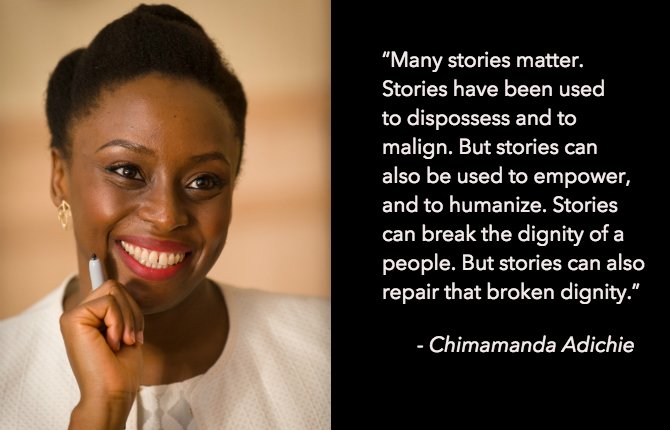Nana Akua Frimpomaa Amofa works at Touchpoint Magna Carta, an Integrated Marketing Communications firm that specialises in Public Relations, Events, & Media. She is also a Writer & Publisher. Connect with Nana Akua via Instagram: @missamofa_ Twitter: @missamofa, LinkedIn: Nana Akua Frimpomaa Amofa, Email: akua.amofa@gmail.com.
Stories have always been part of us, they have played a crucial role in our community and society, helping in the transmission of knowledge for generations. We have always been fascinated by stories and the art and science of storytelling. For many in our part of the world, particularly, Ghana, traditional story telling have been a critical part of social fabric. By the Fireside easily resonates with many as the name Kweku Ananse has been eternalized by same.
Story, Story: Voices from the Market by the BBC Africa, a radio drama series set in Nigeria by the BBC has similar effect. Set in a busy fictional market in the heart of West Africa, it uses drama to trigger discourse and encourages debate among its listeners on various local and global issues including debt, romance, sanitation, bribery and corruption, self-help, community spirit among others.
Stories are powerful, whether anecdotes or scripted – they influence and shape perceptions, narratives and opinions, promoting culture, championing advocacy and change. While we acknowledge the positives and important role storytelling plays in society, we have also seen the damage and adverse repercussions of stories. Acclaimed Nigerian Writer, Chimamanda Ngozi Adichie throws more light on this in her famous 2009 TEDx speech, The Danger of a Single Story, where she explores the negative impact that a single story can have and identifies the roots of these stories. Jim Jones’ Revolutionary Suicide and the narratives that led to the 1994 Rwandan Genocide buttress this point.

In effect, stories matter – irrespective of how insignificant or irrelevant someone might think a story is. Everyone has to be intentional about the way they go about telling their stories. As Public Relations and Marketing Communications Professional Edward Israel-Ayide puts it, “Stories bring meaning. And when we learn something new or share something that makes us want to share it, we unleash something deep within us.” Over the years, storytelling has played a crucial role in building some of the most popular world-class brands. Deliberate efforts to share the beliefs and purpose of brands have endeared them to many. Brands like MTN, Nike and Apple are endearing to many because of stories they share and what others share about them.
By leveraging the power of storytelling, brands and businesses are able to connect with their target audience, establish a strong brand identity and build lasting relationships with customers.
As the public relations profession continues to evolve, the strategic tool of storytelling remains critical to its growth and success. From PR campaigns to press releases, articles, blog posts, CSR initiatives among others, there is always a story or an element of storytelling. It is a powerful way to connect and communicate with your stakeholders, shape brand narratives and influence public perceptions to create the desired impact.
Here are some steps you can consider to incorporate storytelling into your PR efforts:
1. Identify and understand your audience: You need to identify and understand your target audience. this helps you to determine what stories will resonate with them. Stories that may typically resonate with the millennial demographic may not necessarily resonate with Gen Zs. An understanding of your audience will guide the storytelling techniques or approach to employ that suit their interests and needs to reach the respective audiences and also determine which channels to use. Till date, some of the most iconic Ghanaian campaigns and ads we remember are because most of them resonated with us. One of such campaigns which resonated so well with many Ghanaians especially the youth was well the Fan Yogo’s “Shine Your Hustle” which was launched in 2021.

2. Craft a compelling narrative: At the core of impactful storytelling is the ability to craft a compelling narrative that strikes a chord. To do so, you need to consider a lot of factors including brand values, unique selling points, target market and overall objectives to develop stories that align with audience interests, aspirations, and sentiments. Let’s cast our minds back to Me Nsa Aka – MTN MoMo’s first ever commercial. In 2009, MTN set to redefine the course of Ghana’s financial sector with the launch of MoMo. Mobile money was nascent at the time so the brand had to develop a concept that will resonate with and appeal to Ghanaians. It was a solution that was going to provide ease and convenience in payments and transactions that the traditional banking system did not provide at the time.
The commercial, which was first aired on TV and later adapted for radio and print, opens with a woman in a village shouting joyously “Me nsa aka ooo” which means “I have received it.” Her screams attract the entire community who join in the jubilation and follow her to the river side where she informs her husband, she has received a cash transfer from their son in the city. Amidst the jubilation, a young boy asks “na sika no wo hen” to wit where is the money.
The woman then goes to a mobile money vendor and withdraws the money. That TVC set the tone for the gradual acceptance of MoMo by Ghanaians. The concept resonated with the everyday Ghanaian. With majority of Ghana’s workforce in the informal sector, mobile money was a great intervention to bring financial services to the doorstep of Ghanaians, especially Ghana’s unbanked population.
Fabric, a PR campaign by Siemens which won the Best in Show at the 2019 African SABREs used medium of fabric to tell stories about several major African cities, and to spur conversations about the ways in which data, combined with smart technology, can ensure that tomorrow’s African cities are more connected, efficient and powered.

3. Be authentic and relatable: Authenticity is vital in storytelling. Establishing authenticity elicits credibility and trust. It should never be compromised. Now, more and more people are looking for genuine and authentic brands to engage with. Sharing real experiences, successes and even challenges show the brand’s transparency and acknowledgment of its shortcomings and measures being put in place to address them. In today’s ever evolving world, authentic storytelling can go a long way to differentiate your brand and build a brand’s reputation.
4. Use human-interest stories: Using human interest stories can contribute to public relations success. People love and resonate with stories about other people. Staff showcasing, sharing stories about customers, communities or people who have been positively impacted by your brand or benefited from some CSR initiatives, empowerment programs, sustainability efforts among others helps to build strong emotional appeal. This goes a long way to help organizations connect more with their audience, build brand loyalty and create long lasting impact.
As part of its 80th anniversary, Accra Brewery Limited did a corporate documentary on its journey since its inception in 1931. The documentary featured some past Managing Directors, staff, customers and other stakeholders about their experiences with Accra Brewery Limited and why Club still remains the nation’s No.1 beer. The Africa Moves Innovation Series, a docu-series by the Goalkeepers initiative under the Bill & Melinda Gates Foundation leveraged storytelling to showcase stories of innovation from South Africa, Nigeria and Burkina Faso of individuals and organizations making a difference through social impact and entrepreneurship.

5. Visual storytelling: Video content has become the most preferred with diminishing attention span and changing customer needs and interests. Beyond stories, incorporating visual elements can convey emotions and information more effectively. Visuals and content in the form of images, infographics, videos among others can go a long way to enhance storytelling.
Beyond a news story in print or online platforms about a CSR project an organization has undertaken in communities they operate, a video or documentary on the initiative, and its impact on the communities and beneficiaries contributes to impactful storytelling. Also converting data from campaigns, media coverage among others into infographics, charts among others can help to make better sense of data that can be shared with various stakeholders to show the brand’s progress, challenges and way forward.
6. Use a multi-channel approach: Today’s digital world presents us with the opportunity to leverage varied channels and approaches to distribute stories. Multi-channel storytelling enables PR professionals to optimize reach, engage with diverse audiences, and establish a consistent brand narrative across various touchpoints. PR professionals should maximize the various platforms available to amplify their brand and reach wider audiences.
From social media platforms to branded content, organizations can disseminate their stories across diverse channels, tailoring the content to suit the platform while maintaining consistency in messaging and the preferences of their target audience. You can also create story arcs that are in diverse forms to enhance engagement and build sustenance.
7. Showcase your brand’s values: Incorporate your brand’s values and corporate social responsibility initiatives into your stories. Today, global issues like Sustainability, Environmental, Social and Governance (ESG), Diversity, Equity & Inclusion (DE & I), the United Nations, Sustainable Development Goals, (SDGs) among others have become of key interest to various stakeholders including potential investors, general public, employees among others. Brands need to showcase initiatives and projects they are undertaking to portray their commitment to a more sustainable and inclusive future.
Showing demonstrable impact and work towards climate change, strong corporate governance, creating a diverse and inclusive work environment or reducing inequality in communities they operate in among others are very vital. Demonstrating your commitment to social and environmental causes can make your brand more appealing and socially responsible. Companies like Guinness Ghana Breweries have shown strong commitment to sustainability, ESG and diversity and inclusion and have implemented and executed various initiatives in line with these across their brands including the Guinness Ghana partnership with Coliba, a plastic waste recycling company to set up buyback centres as part of the company’s plastic sustainability agenda, Malta Guinness Plastic Collection Drive, Johnnie Walker Tree Planting Exercise as part of its Stepping Out of The Box campaign among others.

8. Collaborate with influencers and media: Partner with influencers, journalists, and media outlets to amplify your storytelling efforts. Fostering and building strong relations with influencers and the media can help in amplifying your brand’s story by sharing with their community, and go a long way to build credibility, increase reach.
9. Monitor and measure the impact of stories: Tracking and measuring the performance of your storytelling helps to enhance PR efforts. Analyzing data and metrics such as website traffic, social media engagement, media coverage, and sentiment analysis help to understand the impact of your storytelling efforts. In times past, quantifying the impact of storytelling posed some challenges but with the advent of digital analytics, gaining insights into audience resonance and interests with stories have become easier.
Metrics such as engagement rates, social media shares, website traffic, and sentiment analysis provide valuable data for evaluating the success of storytelling campaigns. By analyzing these metrics, PR professionals can assess their storytelling strategies, what resonates with their audiences, its impact and find ways to maximize and optimize content delivery, and continually enhance their ability to engage and connect with audiences through various storytelling techniques.
The key to successful storytelling in PR is ultimately building and harnessing meaningful relations with your stakeholders, clients and audience. By telling authentic and compelling stories, you can create lasting impact and enhance your brand’s reputation. By harnessing the power of storytelling, PR professionals can captivate audiences, cultivate meaningful connections, and shape and enhance brand narrative. Through authenticity, human interest stories that resonate with stakeholders, leveraging a multi-channel approach, brands and businesses can foster and strengthen relationships with their stakeholders, fostering unwavering brand loyalty and ultimately achieving resounding PR success.





